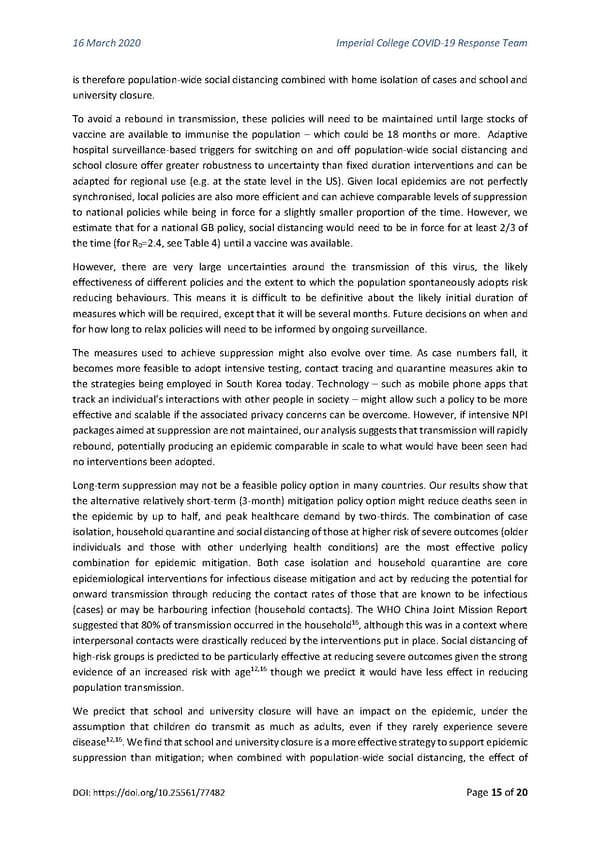16 March 2020 Imperial College COVID-19 Response Team is therefore population-wide social distancing combined with home isolation of cases and school and university closure. To avoid a rebound in transmission, these policies will need to be maintained until large stocks of vaccine are available to immunise the population – which could be 18 months or more. Adaptive hospital surveillance-based triggers for switching on and off population-wide social distancing and school closure offer greater robustness to uncertainty than fixed duration interventions and can be adapted for regional use (e.g. at the state level in the US). Given local epidemics are not perfectly synchronised, local policies are also more efficient and can achieve comparable levels of suppression to national policies while being in force for a slightly smaller proportion of the time. However, we estimate that for a national GB policy, social distancing would need to be in force for at least 2/3 of the time (for R =2.4, see Table 4) until a vaccine was available. 0 However, there are very large uncertainties around the transmission of this virus, the likely effectiveness of different policies and the extent to which the population spontaneously adopts risk reducing behaviours. This means it is difficult to be definitive about the likely initial duration of measures which will be required, except that it will be several months. Future decisions on when and for how long to relax policies will need to be informed by ongoing surveillance. The measures used to achieve suppression might also evolve over time. As case numbers fall, it becomes more feasible to adopt intensive testing, contact tracing and quarantine measures akin to the strategies being employed in South Korea today. Technology – such as mobile phone apps that track an individual’s interactions with other people in society – might allow such a policy to be more effective and scalable if the associated privacy concerns can be overcome. However, if intensive NPI packages aimed at suppression are not maintained, our analysis suggests that transmission will rapidly rebound, potentially producing an epidemic comparable in scale to what would have been seen had no interventions been adopted. Long-term suppression may not be a feasible policy option in many countries. Our results show that the alternative relatively short-term (3-month) mitigation policy option might reduce deaths seen in the epidemic by up to half, and peak healthcare demand by two-thirds. The combination of case isolation, household quarantine and social distancing of those at higher risk of severe outcomes (older individuals and those with other underlying health conditions) are the most effective policy combination for epidemic mitigation. Both case isolation and household quarantine are core epidemiological interventions for infectious disease mitigation and act by reducing the potential for onward transmission through reducing the contact rates of those that are known to be infectious (cases) or may be harbouring infection (household contacts). The WHO China Joint Mission Report 16 suggested that 80% of transmission occurred in the household , although this was in a context where interpersonal contacts were drastically reduced by the interventions put in place. Social distancing of high-risk groups is predicted to be particularly effective at reducing severe outcomes given the strong 12,16 evidence of an increased risk with age though we predict it would have less effect in reducing population transmission. We predict that school and university closure will have an impact on the epidemic, under the assumption that children do transmit as much as adults, even if they rarely experience severe 12,16 disease . We find that school and university closure is a more effective strategy to support epidemic suppression than mitigation; when combined with population-wide social distancing, the effect of DOI: https://doi.org/10.25561/77482 Page 15 of 20
 Non-Pharmaceutical Interventions to reduce COVID-19 mortality and healthcare demand Page 14 Page 16
Non-Pharmaceutical Interventions to reduce COVID-19 mortality and healthcare demand Page 14 Page 16